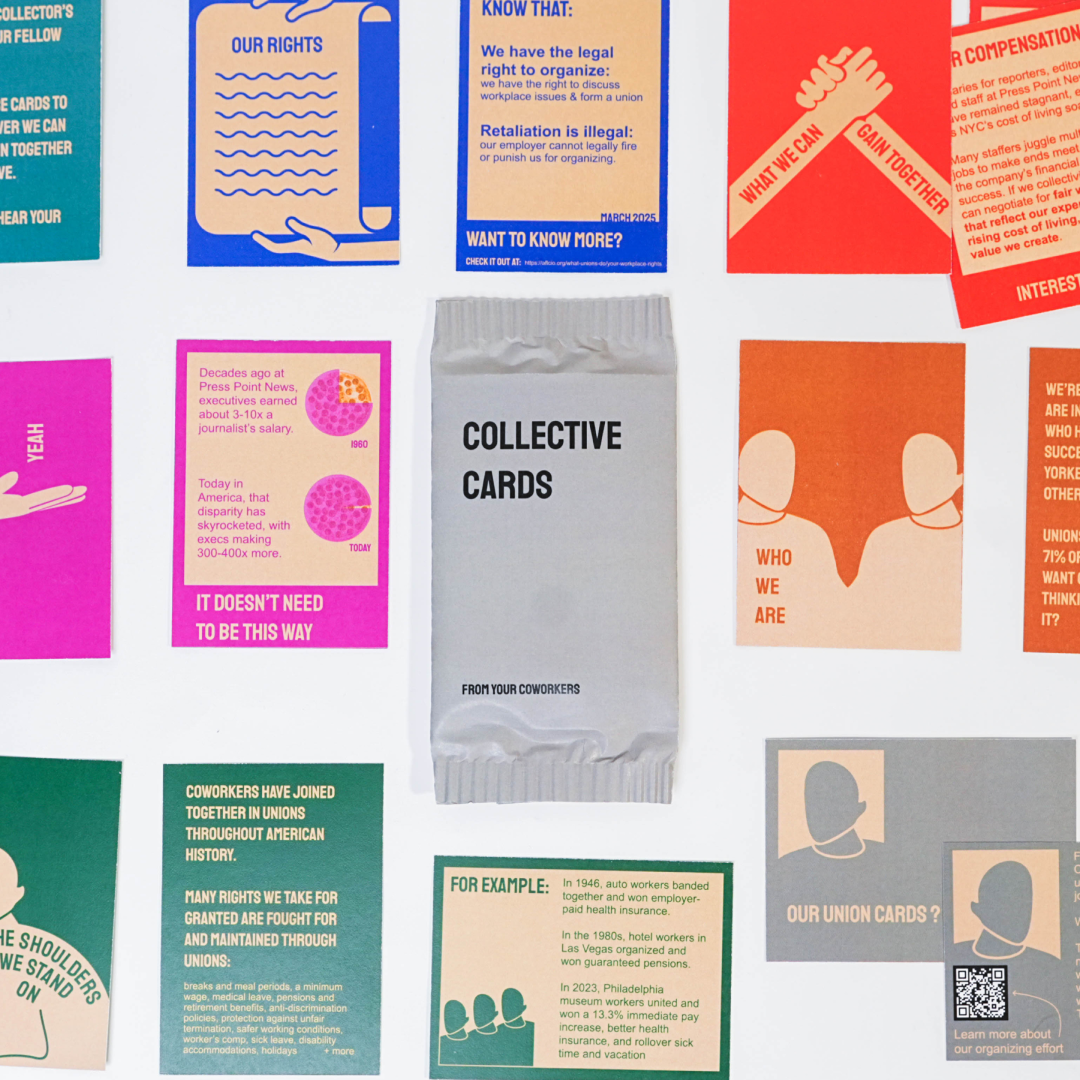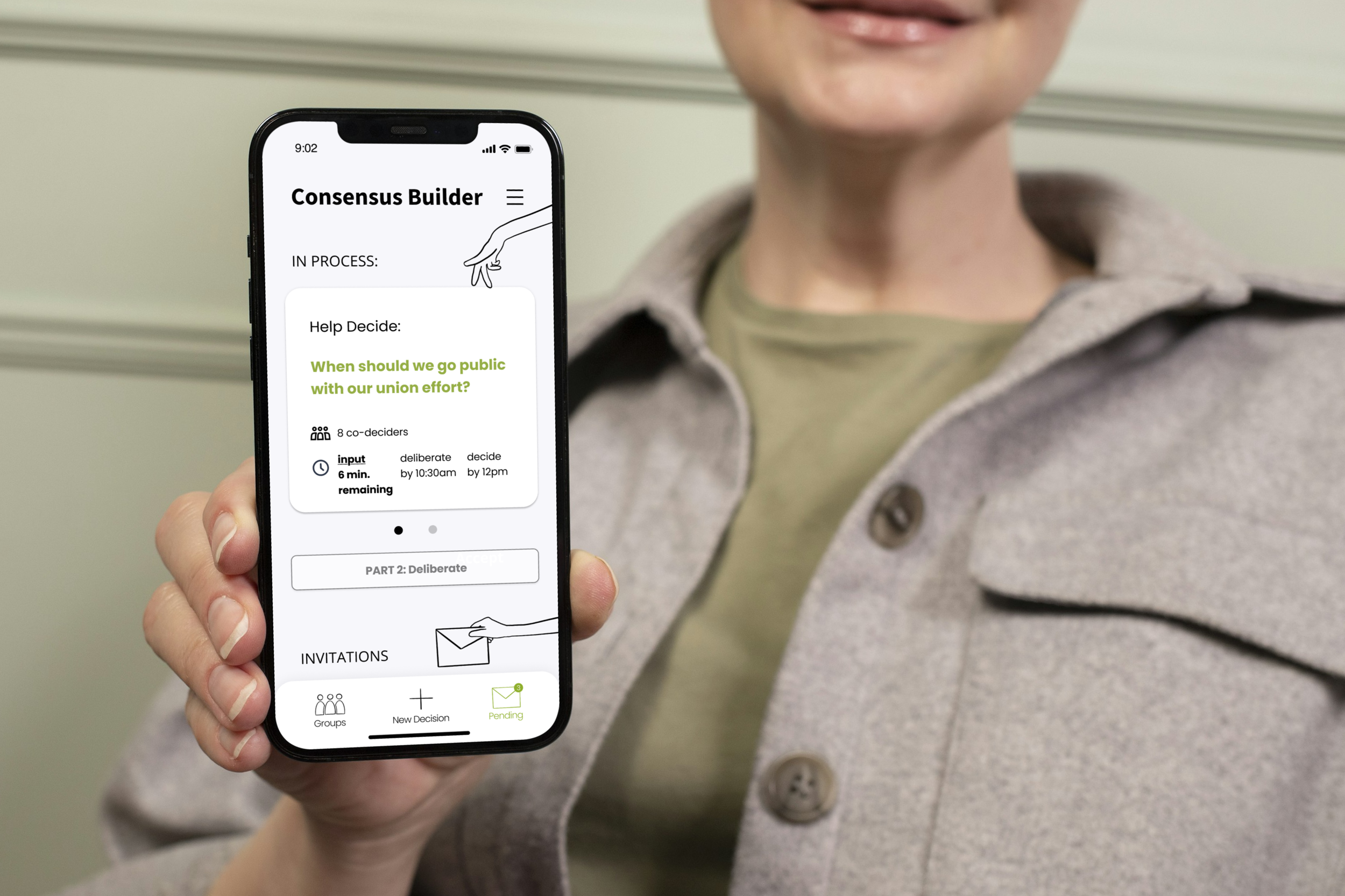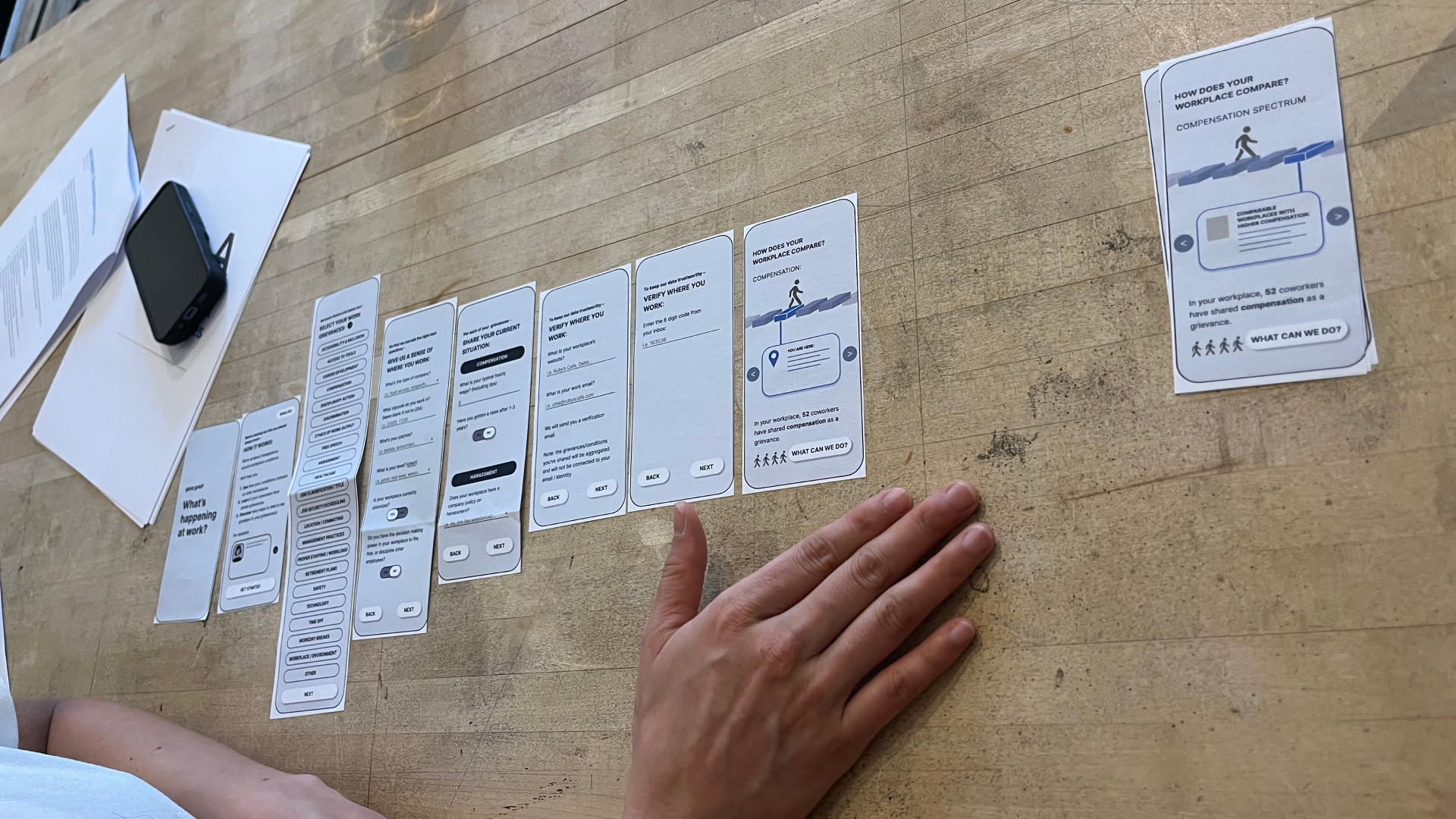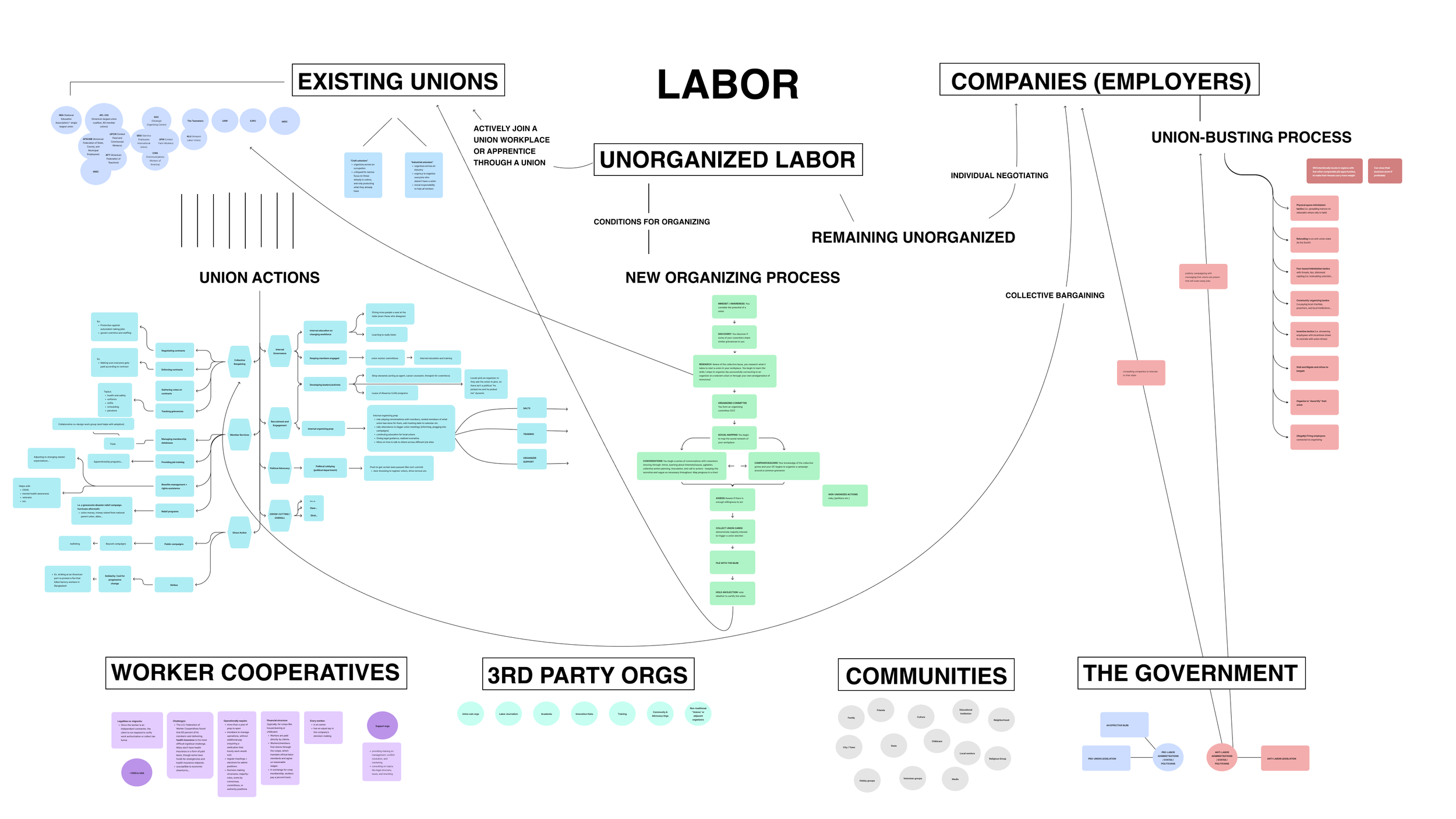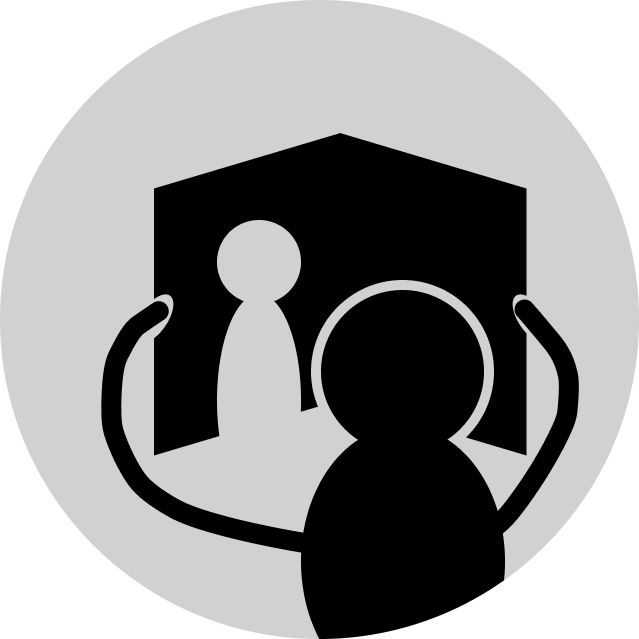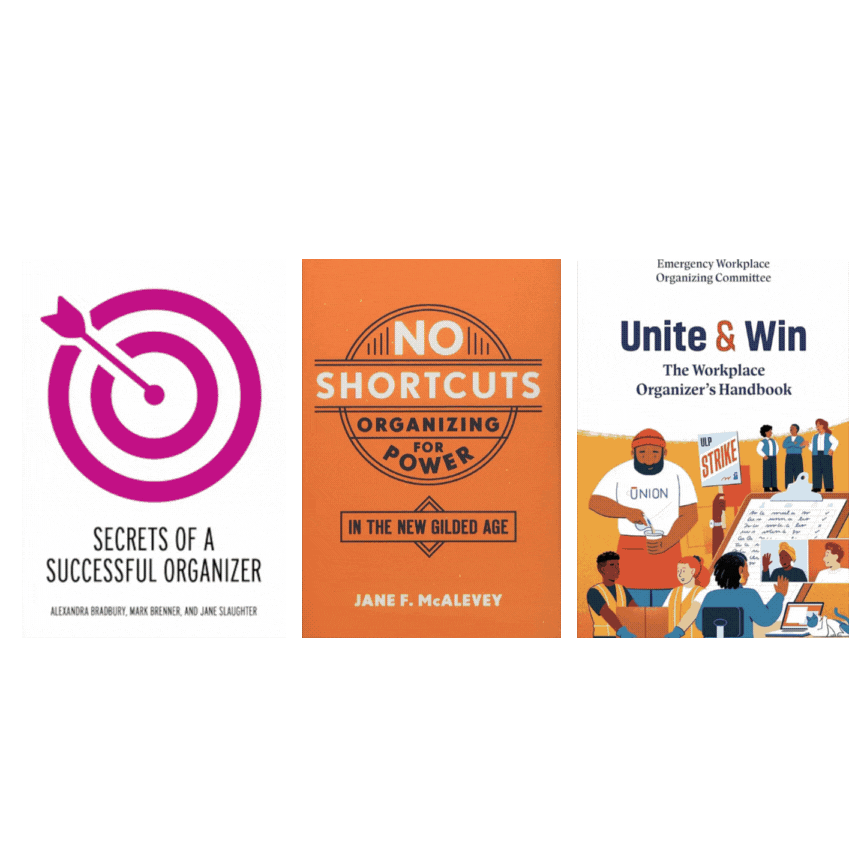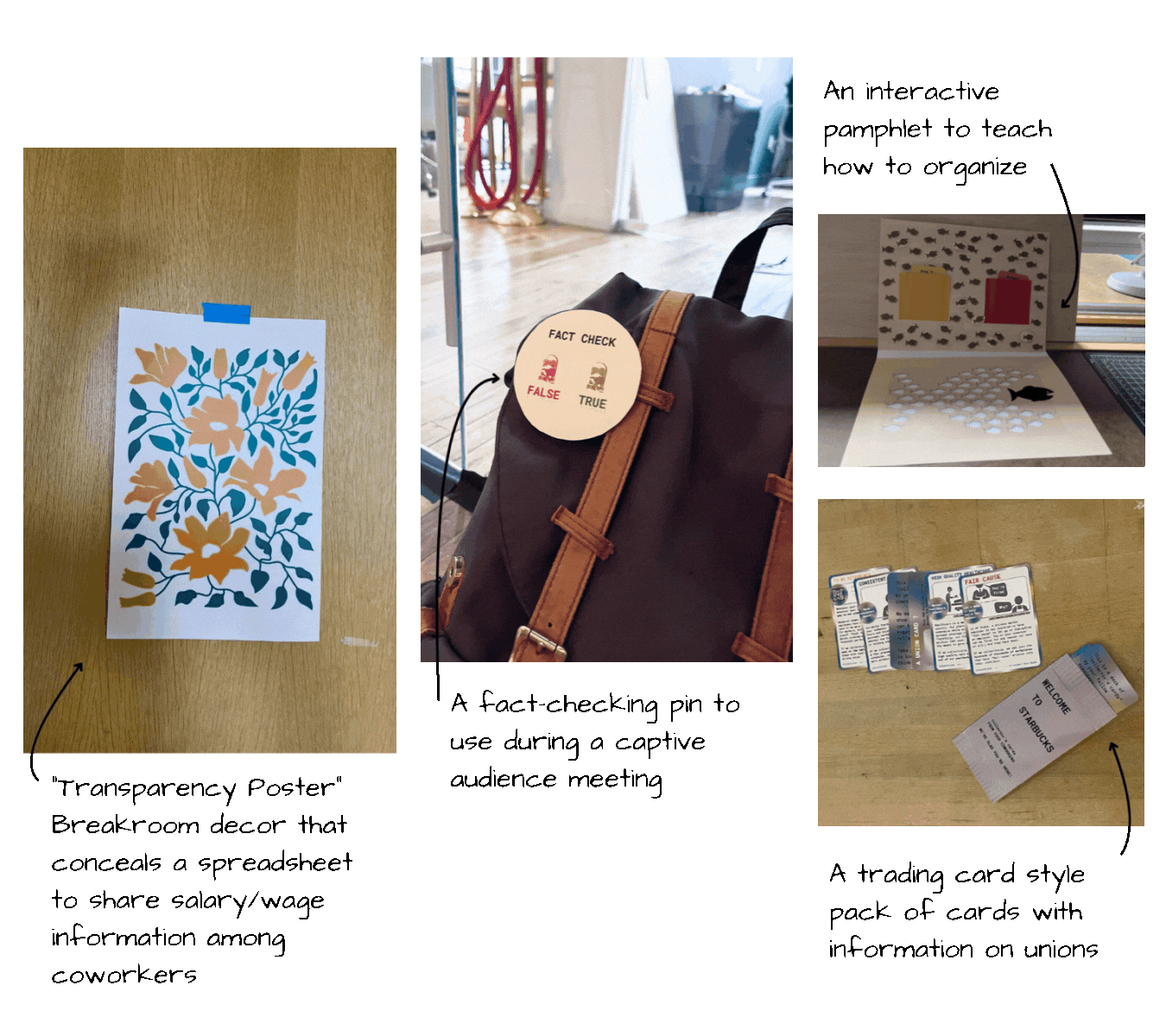
COLLECTIVE
POWER TOOLS
Increasing Capacity for Worker-Led Organizing
OVERVIEW: This body of work consists of 5 tools designed for organizing unions and building collective power in the workplace.
Design is largely driven by industry – leaving many workers to either organize with tools not built for them or to never organize at all. My design practice asks: how might we increase capacity to create solidarity, consensus, and collective strength in ways that feel safe, energizing, and scalable? By lowering emotional and logistical barriers, these projects aim to make the early steps of worker-led organizing of unions more accessible.
These projects are from my master’s thesis in the Products of Design program at the School of Visual Arts. They were created through a participatory design process in collaboration with labor organizers across industries.
CONTEXT:
Participatory research and design, prototyping, UX, UI, testing, service design, experience design, communications design
SKILLS:
Project 1:
Good Grievance
Project 2:
Organizing Gym
Project 3:
1-800-ORGANIZE
Project 4:
Collective Cards
Project 5:
Consensus Builder
Click a project above to skip through to its design or scroll through the overarching process below first.
PROCESS
Stage 1:
RESEARCH
Stage 2:
SCOPE AND DEFINE
Stage 3:
IDEATE
Stage 4:
PROTOTYPE AND ITERATE
Stage 5:
EVALUATE AND REFINE
PARTICIPATORY RESEARCH & DESIGN
To ground my thesis in the realities of labor organizing today, I began having conversations with workers, organizers, and leaders in the broader labor ecosystem. These early discussions narrowed my focus to the early stages of forming a union. I continued developing my thesis through interviews, workshops, desk research, trainings, and local labor actions – exploring the barriers people face and the resources they rely on when organizing collectives in their workplaces.
-
Key Resources:
The Hammer: Power, Inequality, and the Struggle for the Soul of Labor, Hamilton Nolan
Power At Work blogcasts, The Burnes Center for Social Change
Labor Notes magazine, staff writers
Fight Like Hell: The Untold History of American Labor, Kim Kelly
For more recommended books, articles, documentaries, and podcasts, see my notion database.
-
To shape the focus and direction of my thesis, I spoke with labor journalists, organizers, and leaders in unions and adjacent orgs, including those leveraging design and technology for worker power. They provided me with a bird's eye view from their lens working within:
The Workers Lab
Tech Solidarity Lab
Labor Notes
The Workers’ Algorithm Observatory
Coworker.org
National Employment Law Project
Inscriptiv
Pando
Action Network
Union Built PC, Inc.
Labor journalism
Unions
As I developed design concepts and prototypes, I conducted participatory interviews with organizers to test ideas, gather critique, and iterate based on their insights. I cast my net wide, speaking with people organizing in their workplaces across:
food service
nonprofits
education
journalism
tech
meatpacking
building trades
hospitality
fitness
architecture
film
retail
and more
-
Early in the process – I designed, conducted outreach for, and facilitated a workshop to better understand what is mobilizing people to organize their workplaces, what the barriers to entry are, and what challenges they face in turning their dreams for organizing into a reality. This workshop and surrounding conversations helped steer my design inquiry.
Across the workshop and user interviews, I used prototypes and visual aids to center our conversations and invite collaboration.
-
I immersed myself in established organizer trainings held by EWOC and Labor Notes. Drawing from these grounded, community-rooted approaches helped me focus on amplifying existing strengths rather than reinventing solutions.
I also attended local labor actions in New York City, including a Starbucks Workers United picket line and an art build supporting the Sesame Street Workers Union, to stay engaged with ongoing efforts and learn in real time.
Joining active trainings and actions allowed me to meet my “user” where they were – especially important given that organizers are already stretched thin. -
To share back what I was learning with all involved, I created a newsletter for my research community that included emerging themes and process updates as a way to sustain dialogue and share insights in reciprocity.
Overarching Challenge:
UNION MEMBERSHIP HAS BEEN DECLINING,
at nearly the same rate as inequality has risen, due to policies that have raised barriers to unionize in America since the 1980s.
INTEREST IN UNIONS IS CURRENTLY GROWING,
with 70% of Americans supporting unions and over sixty million people wanting to be in one. (SOURCE: Economic Policy Institute)
GAP
This gap illustrates a deep issue: the path to unionizing is full of friction, even for motivated workers.
Each project in my thesis addresses an obstacle along that path (which I’ve mapped below) – all in support of making collectivizing more accessible.
Good Grievance!
Project 1:
A Productive Place to Vent
PRIMARY USERS: Unorganized workers
Good Grievance! is a mobile site where everyday people facing negative workplace conditions can productively vent – gaining transparency into shared struggles with coworkers and seeing how organizing at comparable workplaces has improved conditions. By seeing oneself on a spectrum and in a historical timeline, users can realize that their conditions aren’t fixed. Change is possible.
PROCESS HIGHLIGHTS
Early in my research, leaders in the labor movement raised with me the need for better “marketing” of unions – not necessarily when a union drive is already underway but long before that.
CONTEXT:
“[One of the] biggest challenges is: getting more people to have the thought in their mind of like ‘hey, we should have a union here.’ Something shitty happens at work and instead of just being like ‘my job sucks,' [thinking of a] union. You know, that by itself is really key.”
- Hamilton Nolan, organizer, labor journalist and author
SOURCE: subject matter expert interview
I began ideating around this opportunity area and put a series of low-fidelity mockups in front of labor organizers, voicing over simple user stories for reactions. Most of the concepts themselves wound up in the bin, but the feedback shaped my direction toward a tool that helps facilitate a mindset shift from being disgruntled at work to seeing an opportunity for organizing.
EARLY IDEATION:
Between desk research on the labor movement, interviews with organizers and everyday workers, and a landscape analysis on existing tools, more insights emerged:
KEY INSIGHTS:
The desire to vent about a negative experience or find out its legality can lead to an online search, making it a viable starting point to reach users.
Existing digital spaces fall short of building worker power. Reddit can be overwhelmingly open ended. Glassdoor has a somewhat narrow focus on wages and is primarily for people in job transitions.
The living history of working conditions (as fought for and won by organizing) is often lost, leaving people without context as to why things are the way they are and an assumption that conditions are permanent.
Relatable stories drive interest in unionizing. Currently, unions at Amazon, Trader Joe’s and Starbucks are driving popular interest.
As I prototyped Good Grievance! I began to test the biggest risks and assumptions.
My first iteration relied on a high risk assumption: users will be willing to share their specific workplace name and even verify it. However, my user interviews surfaced that this friction would deter many from completing the user flow.
After the test, I went back to the drawing board and to the basics. Did we really need this data and in this way? To meet the site’s goals, users only need to see one comparable company, at minimum, that has organized for a better condition. The existing flow was overcomplicated. Instead of using the site for data collection (like Glassdoor), key information could be sourced from unions, research institutes, and journalism. Users could still verify where they work if they want to see how many coworkers are feeling the same way, but the site’s success no longer needed to hinge on users inputting that level of detail.
TESTING:
With continued time, I would explore other UI design options for data visualization, test more assumptions, and determine which resources to point users to at the end of the user flow.
WHAT’S NEXT:

FEEDBACK ON GOOD GRIEVANCE!
This is really really cool. I think so many times, organizers only look at their own history and it’s very cumbersome to look at other industries. There are databases out there that have this information that is really overwhelming. A strong user interface for consistency in looking at conditions is a really valuable thing.”
“
- Organizer of a union in the film industry
Organizing Gym
Project 2:
Exercise (Y)our Power
PRIMARY USERS: Union-curious people
Organizing Gym is a workout class that teaches the fundamentals of unionizing through movement. Each exercise in the class represents a step in the organizing process – from social mapping to escalating collective actions – helping participants gain an overall sense of the process and walk away with it as muscle memory. Designed as a curriculum, “Organizing Gym” can be offered by unions and worker centers at scale through partnership with local fitness instructors. The class is adaptable for different gym setups and offers an energizing, embodied entry point into organizing.
PROCESS HIGHLIGHTS
While no studied statistic exists, anecdotally most people who aren’t already in a union don’t know how to form one. With union membership in constant decline despite popular support for unions rising to 70% – this knowledge gap has significant implications for the future of union membership.
CONTEXT:
“Dunno.” “Gather a group of people together.”
“Meet, write charter, vote” “Legal paperwork?”
“I feel like all I know is you should keep it hidden from bosses lol”
Responses to the question: “What do you think it takes to form a union?”
SOURCE: my pre-gym class survey
If union curious, one may search online and expect to read a guide. Moving beyond this one-sided intake of information (reading, watching, listening) may involve conversation with an established union organizer and attending trainings. Trainings can risk feeling dry (i.e. watching powerpoint slides), difficult to access (needing to be “in the know” to find them), and feeling similar to work – perpetuating the slog of doing work outside of work. The more interactive and experiential the training, the better.
EXISTING RESOURCES:
With this in mind, I thought: how might we introduce the process of organizing a union to everyday people in a way that is inviting, energizing, and that fits into their life outside of work? What better way to energize than a workout class? I began drafting a curriculum. To bring in proper expertise, I reached out to and collaborated with fitness instructors who have done their own organizing in that industry. I made swag, put together a playlist, and ran the first facilitated gym class as a proof of concept. Participants, surveyed before and after, expressed greater interest in and awareness of unions and how to organize one.
EXPERIENCE DESIGN:
This exercise class is packaged as a curriculum that unions and worker centers can partner with local gyms to offer at scale.
Interested in hosting or facilitating your own Organizing Gym? Reach out!
DESIGNED FOR SCALE:

FEEDBACK ON ORGANIZING GYM
It wasn’t stressful! When you talk about topics like this it can be very stressful and when you explain it in an academic way people may get a little bit lost. But this way is more fun, it’s less stressful, it feels more straightforward and I think the kinesthetic side of it makes it easier for people to get the concept.”
“
- Organizer of a union in the meatpacking industry
1-800-ORGANIZE
Project 3:
Practice Makes Power
PRIMARY USERS: Budding organizers
1-800-ORGANIZE is a peer-to-peer hotline for budding organizers to practice the conversations they’re preparing to have with coworkers – upping their skills, building solidarity, lowering anxiety, and increasing their chances of success in forming a collective. It is designed to scale up the success of existing labor trainings, where participants are often paired into breakout rooms to roleplay organizing conversations.
CLICK PLAY (NOTE: THIS VIDEO HAS SOUND)
PROCESS HIGHLIGHTS
As of 2023, there are over sixty million Americans wanting to join a union in their workplace. The process to form one, however, is very challenging and requires many one-on-one, specific conversations between organizers and their coworkers.
These labor organizing conversations require skill. It’s skill that can be taught through trainings, but these are often one-off. With limited resources, scaling up trainings and building on their momentum is a challenge.
CONTEXT:
“There aren’t enough [union] staff people to make that change happen…Our job is to teach people the skills they need to have a voice at work, to teach people to have conversations. I can’t talk to a million people… but their coworkers can.”
– David Cann, AFGE Organizing Director
SOURCE: Power at Work Blogcast #79: What Could Happen Under Trump?: The Future of Organizing
“In my experience with trainings, there’s never enough. I feel like to get good at something you have to practice it like a hundred times. but it’s like, ‘Oh no, we had one zoom call, and now I’m supposed to go talk to my coworker?’”
- Organizer of a union in an architecture firm
SOURCE: user interview
I attended organizer trainings hosted by EWOC and by Labor Notes: both low entry point, well-regarded resources for early organizers across industries. In almost every training, participants are taught a skill (ex. the 80/20 rule — listen 80 percent of the time, talk 20 percent) and placed in 1:1 breakout rooms to practice through role-playing an organizing conversation.
1-800-ORGANIZE is born from asking: how might we keep the momentum of practice up and amplify the power of peer-to-peer learning in low-stakes, consistently available ways?
SCALING UP SUCCESS:
I designed the hotline to work as follows:
Learn about the hotline at a labor training/event.
Text the hotline.
Answer a handful of questions about the conversation you’re looking to practice.
Enter a call, paired with another person to role-play.
Volunteer as a receiver a few times, and you’ll gain credits to practice more.
Visit the hotline’s website for best practices and example audio clips and scripts for specific talking points.
SERVICE DESIGN:
With continued time, I would explore the following open questions that arose through user feedback:
WHAT’S NEXT:
How early in the “practice” stage should the service begin for users? Maybe there is a stage before practicing an organizing conversation with a peer. For instance, the user could be prompted to record voice memos first and listen back.
Would the option to use a private AI be worthwhile or useful here? Practicing with another real person is hard to beat, but people may feel more free to experiment with a bot. While there’s debate about whether AI should be used at all, some argue that when it’s already being deployed against workers, using it to support them could be a valuable countermeasure.
How can more partnerships come into play? Where would unions and capacity-building labor orgs want the hotline to live and how would they shape how it functions?
Should I focus on scaling the tool vertically or horizontally? To scale vertically may include a data strategy, much like other text hotlines, to inform other union programs. Scaling horizontally may include applying this “practice makes power” method to other organizing movements.

FEEDBACK ON 1-800-ORGANIZE
I like the idea of this being a momentum builder. People don’t do anything after the trainings. They’re trained, but they’re not practicing the skill. I also like how it walks through certain talking points. Like when people ask about dues for voluntarily joining a union. I struggle with that.”
“
- Organizer of a union in the tech industry
Collective Cards
Project 4:
From Your Coworkers
PRIMARY USERS: Organizers
Collective Cards are covert yet friendly print materials, designed in the spirit of collectible trading cards, that organizers can use as aids and leave-behinds during conversations with coworkers. Tear open a pack and find approachable information on workers’ rights, common grievances, and the value of acting together. Organizers can customize decks to fit their workplace and choose to DIY print or order them for distribution.
PROCESS HIGHLIGHTS
Increasingly in America, companies are siloing their workers. Remote and atomized work, high turnover, and workplace surveillance are just a few of the factors isolating coworkers and slowing personal rapport building across a company. This makes organizing extra challenging – as interest in a union spreads best through a ‘social map’ of relationships. With gaps in those relationships, some coworkers require a “cold call” introduction to a union drive. Because of the secretive nature of organizing and fear of retaliation, making this first communication warm and inviting is a challenge.
CONTEXT:
“I was emailed by one of the main organizers trying to organize [us]. The way [they] reached out was so cryptic, cloak and dagger… I eventually took a call… I said I’d sign [a union authorization card] but I didn’t. It got deprioritized.”
- A faculty member during a college’s union drive
SOURCE: user interview
I turned to other social movements throughout history where people have needed to discreetly unite around an abstract future. I charted their artifacts as well as those used in the labor organizing process today. In organizing these tools, I began learning key characteristics to design with.
LANDSCAPE RESEARCH:
I did not have a clear brief for this project; I vaguely wanted to create a tool that organizers could lean on for support in the context of their workplace. To build out my brief more, I developed some more nuanced criteria.
CRITERIA FOR DESIGN:
I ideated through quick, low-fidelity model making. From these ideas, the cards gained the most traction. Testing them with different organizers and their coworkers highlighted which cards were most effective and the tone needed. I continued to refine the visual language and the information architecture of the cards.
PROTOTYPING:
One of my most important criteria for this project was making it “specific but also replicable”. So, these cards are designed for customization through a template and then ordered or printed DIY style.
DESIGNED FOR SCALE:

FEEDBACK ON COLLECTIVE CARDS
The hardest part of organizing is the first point of contact. It’s not easy to do with someone you’ve only interacted with professionally, and, now, you’re having a conversation about something that implicates their finances and politics too. Anything you can do to mediate that moment is helpful, especially something physical like this.”
“
- Organizer of a union in an architecture firm
I think the pack would work really well as something to receive from a coworker. It’s low pressure but intriguing — like if somebody gave it to me at an event I’d prefer that to getting trapped in a long conversation about the issue. But I would definitely open the pack later because it’s really kind of curious and inviting — like ‘Well let’s see!’”
“
- Professional in journalism and higher education who has experienced two union drives
Consensus Builder
Project 5:
A Better Decisions, Quicker
PRIMARY USERS: Groups of coworkers, friends, or family
Consensus Builder is a group decision-making app that helps people practice the skills of consensus in everyday settings – from choosing a lunch spot with friends to planning a trip with family. Unlike basic polls or majority voting, it invites participants to reflect on their principles, rank options, and work toward decisions where everyone feels heard, without endless unstructured back-and-forths that can stoke tension.
PROCESS HIGHLIGHTS
As a union grows from two people, to three, four, and so on, group decisions come into play – about what issue to campaign around, when to go public, what actions to structure test with, and so on. Using consensus building for certain decisions can benefit a group of coworkers unionizing because it keeps all members engaged and represents the collective. But without helpful frameworks for decision making, a union effort can begin to fall apart.
CONTEXT:
“Our second biggest challenge was decision making processes… I thought maybe with decision making we were moving too slow. The build up of energy was becoming poisoning in some ways. We were becoming resentful of each other… We needed support to learn together what our decision making mechanism would be.”
- Organizer of a union in a nonprofit
SOURCE: user interview
I began studying consensus building as it’s been practiced by indigenous communities, quakers, and activists. In one reading, David Graeber reflected on his experience with consensus building during Occupy Wall Street: “How often does the average American actually sit down, even with a group of four or five people, and try to make a collective decision in which all have equal say? True, children often do it while playing. But, for adults, the experience of democracy is largely limited to decisions involving food, or maybe movies.”
This prompted me to see food as an entry point. If building consensus around what pizza to order isn’t straightforward, then it’s hard to imagine easily picking up the process for more important group decisions, like forming a union.
If we want to succeed in making democratic decisions for a healthier government at a societal level, or at a workforce level with unions, we can begin to strengthen the skills of consensus with lower hanging fruit – in the groups that compose our daily lives: teams, and friends and family.
EARLY IDEATION:
Or maybe I just wanted an excuse to use the words “onion” and “union” together 🤫
To design the user experience, I took core principles of consensus building and converted them into digital, bite-sized actions.
BUILDING UX FLOWS:
CONSENSUS PRINCIPLES
UI PATTERN
Start with a topic instead of a proposal to align the group on understanding the problem together first.
Ask users to reflect on their principles before seeing options to ground decisions in real needs, not surface preferences.
Capture both individual preferences and underlying needs in ways the group can interpret and act on together.
My goal with the UI was to make consensus building feel approachable — not overly earnest or complicated. I used a clean, neutral palette with one accent green, soft-touch illustrations, and the Poppins typeface for a friendly but grounded feel.
I created a lightweight design system to keep the UI consistent and scalable. I applied these components to my wireframes to make future iterations easier to build and extend.
APPLYING A DESIGN SYSTEM:
I entered this project focused on the “during” stage of decision making. However, user interviews with organizers and everyday workers alike brought up hopes that the app would help them with communicating after a decision was reached as well. For instance, team members expressed difficulty communicating their opinions with confidence to a manager. Others expressed a desire to return to old decisions in the archive and learn from them. These insights suggest an opportunity to add a “recap” feature within Consensus Builder that helps both with external communication and internal reflection.
WHAT’S NEXT:

FEEDBACK ON CONSENSUS BUILDER
I would use this now for our union. We just had a situation where one of our workers, we believe, was illegally fired. So, what do we do about that? But we don’t have an understanding of how to look collectively and how to make decisions… Sometimes we just do a vote where majority rules – it’s really loosey goosey. So, thanks for [this app] for helping me think this through… This kind of invites people to use it as a way to guide through sticky situations that tend to break apart groups. That is where things tend to just dissolve is like, ‘Why did we make this decision? Who made it? Did the squeakiest wheel with the most power or the most annoying voice get this done? And so, I think it’s really brilliant to go in and see like: this is where it breaks down. It invites mindfulness and intentionality.”
“
- Labor organizer, organizing in the South for more than 20 years
FURTHER EXPLORATION
To collaborate or to share your perspective related to labor organizing:
To read more about each project and the process:
Many thanks to all faculty at Products of Design at the School of Visual Arts and to my thesis advisor Julia Lindpaintner.





